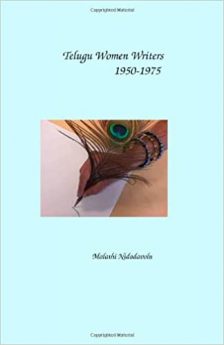Telugu Women writers-18
-Nidadvolu Malathi
The story “Manchudebba” (Frostbite) addressed one of the very rarely mentioned taboos in society,namely, marriage under false pretenses to hide a man’s impotence.
The story opens with Kalyani, a young woman, visiting her grandmother in a small village. She is bored. While on terrace just to pass time, she spots another girl on the terrace next-door, and is about to approach her. The other girl, Vakula, quickly turns around and disappears. Kalyani learns that for some odd reason, Vakula does not speak. That surprises Kalyani since she had known Vakula to be an excellent singer with captivating voice. As story develops, Kalyani learns that Vakula’s husband and his parents spread rumors that Vakula is sick, possessed, and so on and continue to arrange various treatments. They even blame Vakula’s parents of cheating them. On one evening, Kalyani sees Vakula on the terrace for a second time. This time Vakula is accompanied by a psychotherapist.
Vakula opens up to Kalyani and tells her that her husband is impotent. That night Vakula is found dead.
“Pagadaalu” [A Coral Chain], by Achanta Saradadevi, illustrates the shallowness in middle-class values.
A little girl, wearing a chain of corals, went to play with a poor child, who was living with her grandfather down the street. A little later, the girl returned home. The coral chain in her neck was missing. Her mother assumed automatically that the old man had stolen her daughter’s chain. She confronted him. He tried to convince her desperately that he had never seen the chain, and known nothing about it.
Mother was convinced that he was lying and insisted that he either return the chain or pay for it. Since he did not have the chain, the old man ended up paying for the chain with his life’s savings.
After a couple of days, the coral chain was found lying under a cabinet in their own home. The little girl was happy to find the chain. She expected her mother to admit her mistake and return the money she had taken from the old man. She asked her mother jubilantly, “Shall I go and tell the old man that we’ve found the chain?”
Her mother’s response was, “Chi, isn’t that embarrassing! What would the neighbors think of us? Wouldn’t they say that we had the corals in our home all along and known it too. They would say we blamed him needlessly and we had caused him a lot of pain for no reason.”
The story was narrated by the protagonist in flashback. After she had grown up, got married and had a child of her own she recalls her past. Presumably, it had taken all that time for her to understand her mother’s logic. The message I believe is that such false sense of middle-class values is acquired only in later years but not in childhood days.
Hunger is a universal problem. The story, “Idi Katha Kaadu” [This Is Not Fiction] by D. Kameswari, illustrates not only the pain of hunger but also the attitude of the elite towards the poor. The author mentioned that the idea was taken from a real incident she had witnessed and that explains the title, “This is not Fiction”. It was narrated in first person, which made it that much personal.
The narrator, a woman from a well-to-do family, and her neighbors, watched a poor woman rough up her nine-year-old daughter. For all appearances, the mother’s actions were cruel and heartless. The women watching her understood that the mother would not give food to the little girl unless the little girl had picked enough sticks, sold them and brought the money to buy groceries. For them, that was horrendous, the mother’s action was beyond their comprehension. How could any mother be so cruel?
As days passed by, the narrator came to know a few more things about this mother and daughter. The woman’s husband had left her with their three kids for another woman. She had to find ways to feed them all by herself. The daughter, being just a kid, wanted to buy snacks with the income from the sale of her bundle of sticks. The mother wanted the money for food for the entire family.
One day the daughter, craving for snacks, gathered more sticks than she could carry. The weight of a big bundle of sticks on her head, combined with the deadly heat, hunger and lack of nourishment, caused her to collapse and die. The mother was heartbroken.
The neighborhood women had no sympathy for the mother. She deserved it for all they cared.
A few days passed by. One day, the narrator was waiting for her son to come home from school. They were in the habit of eating lunch together after he returned from school. On that particular day however, the son did not come home at the scheduled hour. The mother waited for over an hour and a half.
While waiting for her son, she was beset with several thoughts and emotions—fear, frustration and hunger on one hand, and her rationale to go ahead and have her meal, on the other. Finally, she convinced herself that there was nothing wrong, she could go ahead and have her lunch; she was sure her son was fine; he had a big breakfast in the morning, would have had midday snacks at school. She convinced herself that he was not starving.
After she had finished eating, however, she came to realize the anomaly in her own mode of thinking. “I could not wait for my son past one hour and a half. Is it not ridiculous for me to lecture on subjects like maternal instinct and mother-child relationship?” the narrator reflected.
*****
(Contd..)


